What Happened to MLB's Elite First Basemen?
I have some bad news for Clu Haywood (of Major League fame), Jack Elliott (Mr. Baseball), Lou Collins (Little Big League), Stan Ross (Mr. 3000), George Bush (Yale ’48) and Lou Gehrig (the real Pride of the Yankees) and the 23 other Hall of Famers that made first base a position of glamour and power: first base stinks in the big leagues right now.
The two worst OPS+ for first basemen relative to league splits, at least as full records exist since 1973, have occurred in each of the past two years: 111 last year and 112 in 2018. And the early returns this year are that it’s getting worse. It’s down to 106. First basemen are off to a .226 start.
The last time any other position posted a better OPS+ than first base was 29 years ago–and that “position” was DH. For the first time anybody can remember first basemen have posted a lower OPS than three other positions: shortstop, center field and right field. That just should not happen for a position with low defensive requirements.
It’s not just because Pete Alonso is off to an awful start for the Mets or that no first baseman for the Diamondbacks, Phillies or Blue Jays has hit a home run yet. This is a trend. First base is a position of declining production and few major stars. Some evidence:
• No first baseman has received any of the past 120 first-place MVP votes. Since 2011, only 15 of the 480 first-place MVP votes (3.1%) have been awarded to first basemen.
• No qualified first baseman hit .300 last season for the first time in 48 years. (As recently as 2006 nine first basemen hit .300.)
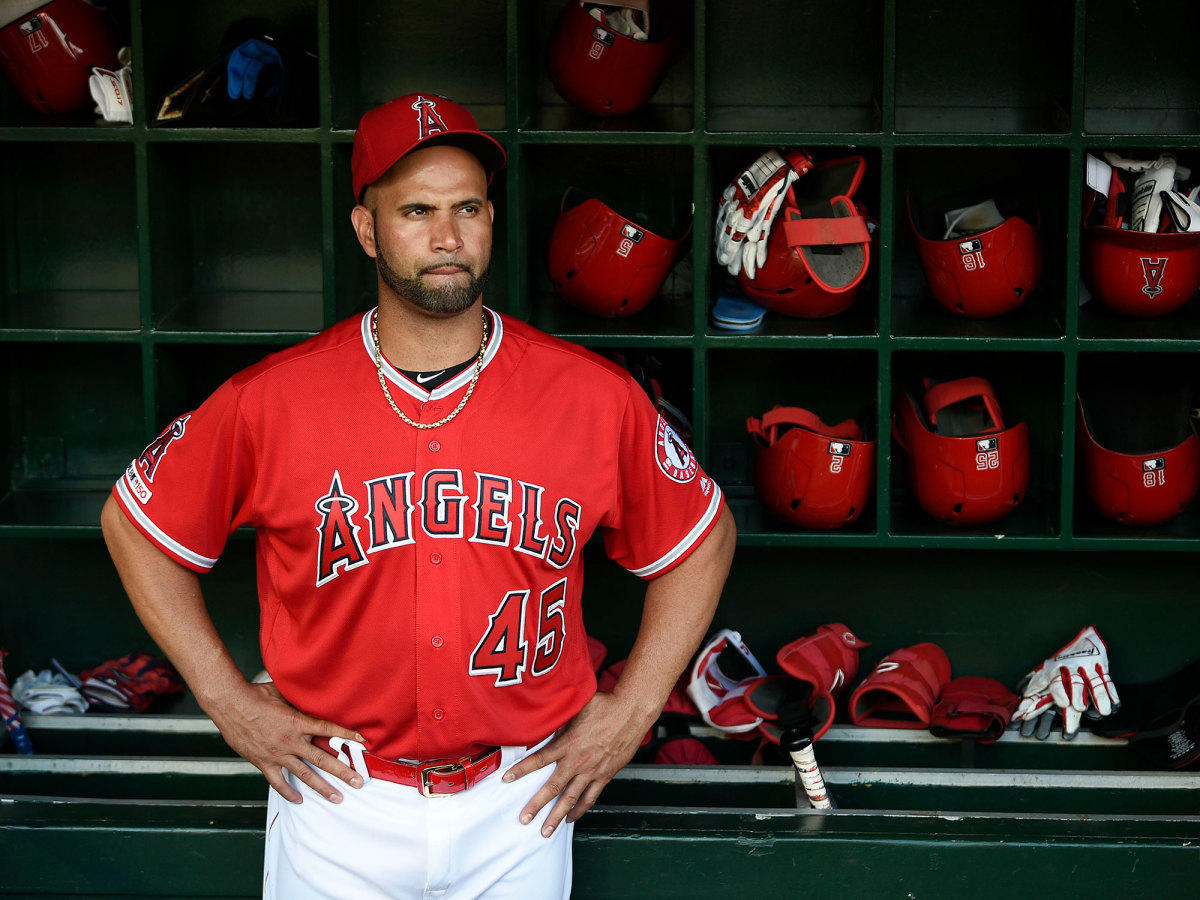
And from last year …
• Marlins first basemen drove in only 62 runs, the fewest in franchise history.
• Royals first basemen batted .220 and posted a .646 OPS. Both marks were the worst in franchise history.
• Reds first basemen drove in only 60 runs, the second lowest for the team in a full season since 1946.
• Blue Jays first basemen managed only 131 hits, the fewest in a full season in franchise history.
• Phillies first basemen collected 131 hits last year and 130 hits the year before. Both marks are the franchise’s worst since 1946.
Remember the glory days–way back in 2009 when Prince Fielder, Adrian Gonzalez, Ryan Howard and Albert Pujols hit 40 or more home runs? It’s taken 10 seasons since then for the same number of first basemen to hit 40.
What in the name of Calico Joe Castle is going on here? The easy answer is that position strength goes through cycles. Shortstop, for instance, posted the worst OPS+ every year from 2010-14. Now they’re the best. We are in a Golden Era of shortstops. The natural ebb and flow of talent is at work.
But there is more. Let’s define the problem and examine some causes.
A Decade of Decline
First base is the least challenging position on the defensive spectrum. So it should not be a surprise that annually it has been the most productive offensive position–by a lot. From 2005-17 first basemen posted the highest OPS+ relative to league average over all other positions by at least four points and as many as 15. But first base has regressed so much in the past two years that the annual gap is gone.
In the past decade the OPS+ for first baseman sunk from 125 to 111. Two years ago it tied the DH spot at 112. Last year it tied right fielders at 111, the worst for first basemen in the 47 years of such recorded history.
Here you can see the rapid decline of first base production:
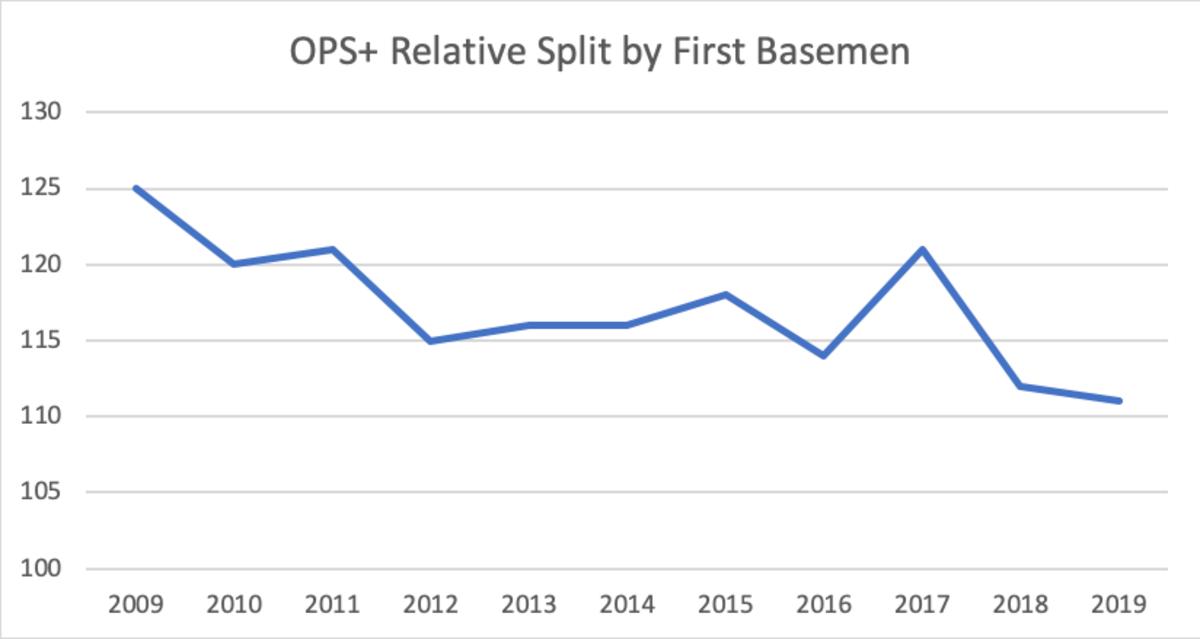
The Gig Economy
It’s not just pitching. Analytically-driven front offices are dividing jobs in search of better production and controlling costs. In 10 years (2009 to 2019) the number of players to appear at first base rose 33%–from 148 to 197.
Steve Garvey is a dinosaur. The number of first basemen with 140 games at the position has been cut almost in half in the last decade:
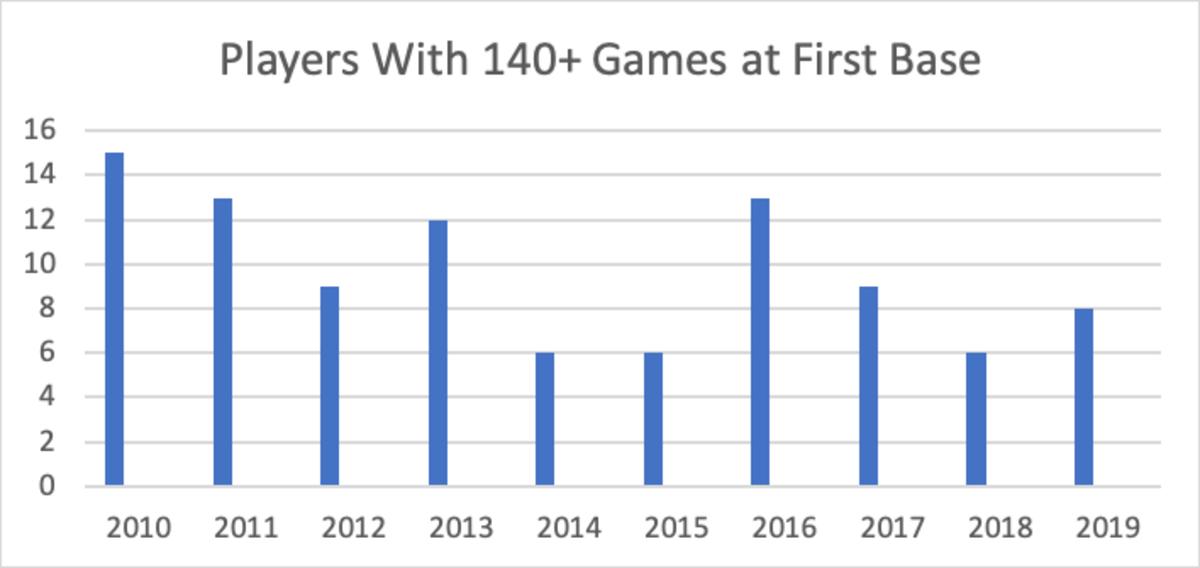
Less Valuable Players
First basemen won 10 MVP Awards from 1993-2010–and none since. (Miguel Cabrera won both of his as a third baseman.) Why? The position is down, but it’s also because baseball writers are using Wins Above Replacement as a definitive measure of value, which is as lazy as using an SAT score as the only criterium for college admission. WAR is no friend of first basemen because of its low defensive weight.
First basemen won both MVP awards in 2006–Justin Morneau and Ryan Howard. They finished 24th and 11th in their respective leagues in WAR, which means it is unlikely they would have won under voting preferences today.
First basemen have become irrelevant not just to the MVP Award but also to MVP discussions, as shown here in the decline in annual MVP voting points given to first basemen:
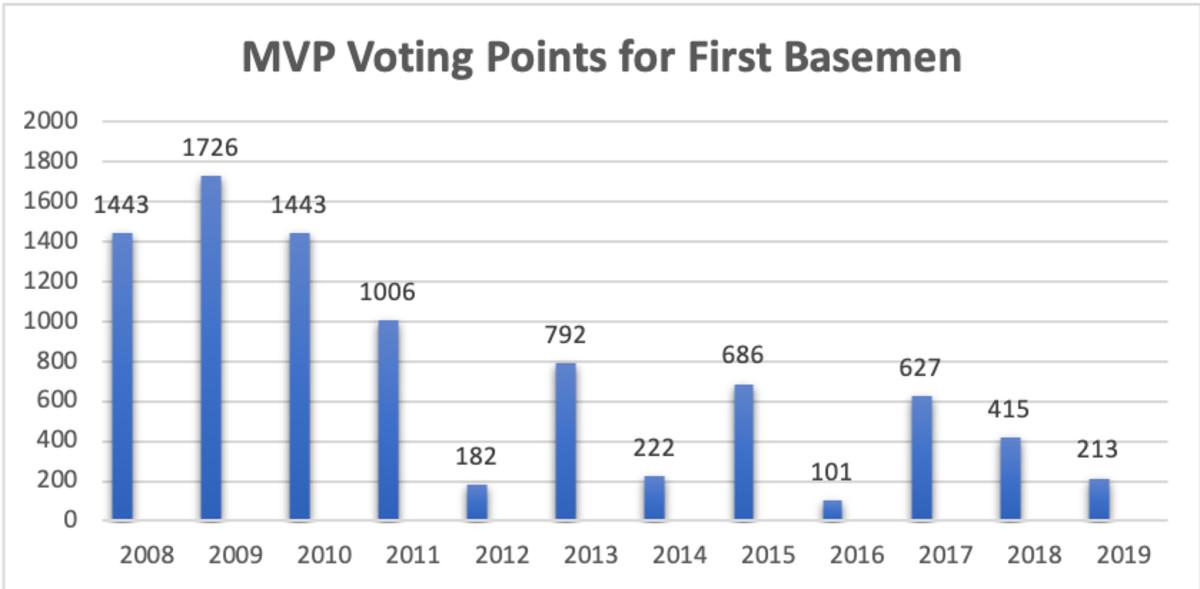
Follow the Money
Teams are not spending money on first base as they once did. Of the eight richest contracts given to first basemen, none were signed in the past four seasons and none belong to a first baseman who is productive today.
Highest Paid First Basemen (Total Value)
Total (Millions) | Year Signed | |
|---|---|---|
1. Miguel Cabrera, Tigers | $248M | 2014 |
2. Albert Pujols, Angels | $240M | 2011 |
3. Joey Votto, Reds | $225M | 2012 |
4. Prince Fielder, Tigers | $214M | 2012 |
5. Mark Teixeira, Yankees | $180M | 2008 |
6. Chris Davis, Orioles | $161M | 2016 |
7. Adrian Gonzalez, Red Sox | $154M | 2011 |
8. Miguel Cabrera, Tigers | $152M | 2008 |
The Aging of an Elite Class
Albert Pujols, Miguel Cabrera, Joey Votto, Ryan Zimmerman, Brandon Belt, Adrian Gonzalez, Mark Teixeira, Jesus Aguilar and Yonder Alonso have made All-Star teams as first basemen in the past five years. Chris Davis was a two-time home run champion. None have aged well.
The next generation of premier first basemen is thin. Last year only four first basemen 25 and under hit 20 home runs (Alonso, Matt Olson, Ryan O’Hearn and Ronald Guzman). In 2011 there were 11 such young sluggers playing first base.
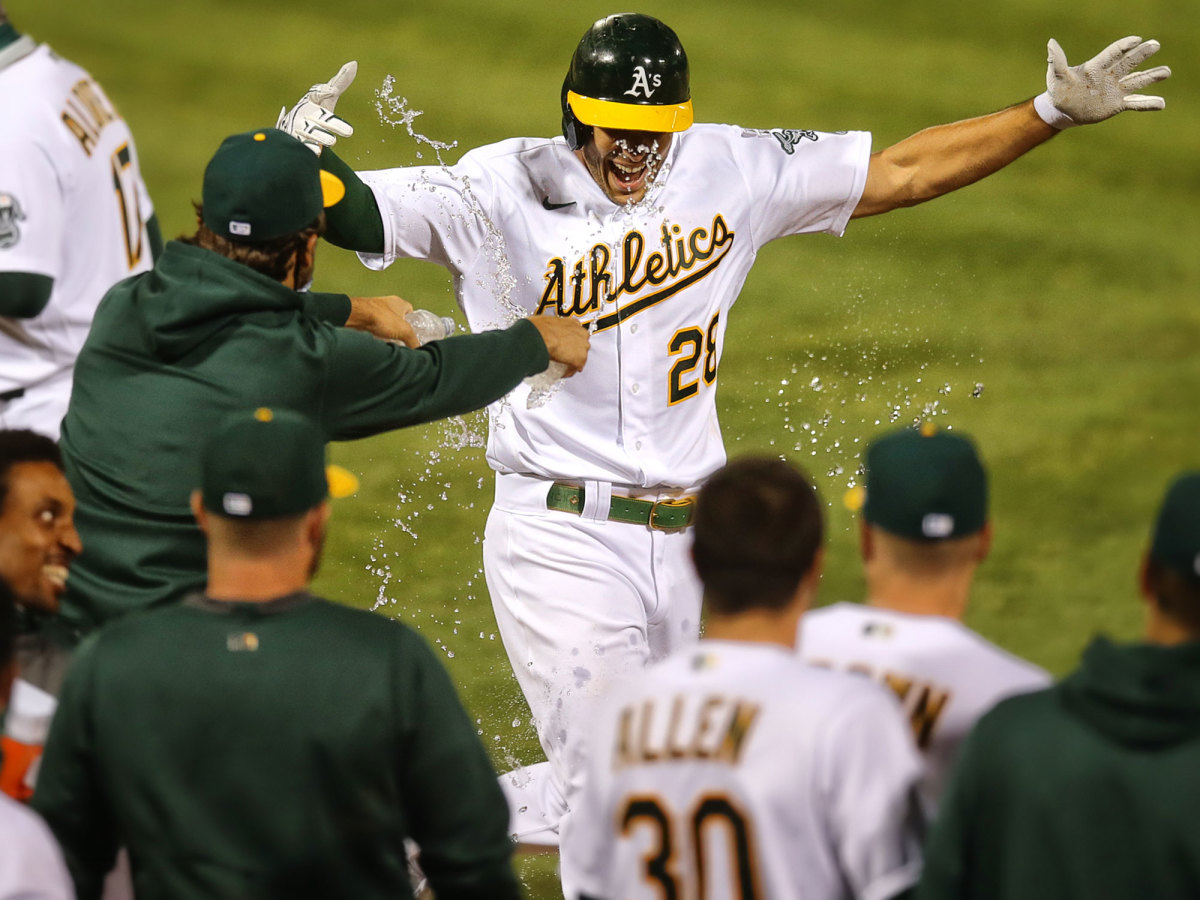
What’s Ahead?
Pitchers are ahead of hitters in this unusual season. The average of 18 strikeouts per game is the highest through the first 10 days of any season. Batting average is .233 (down from .252 last year) and batting average on balls in play is .280 (down from .298). Those numbers are too low not to get better.
First basemen are bound to finish with a better average than .226, the current state of the position–but perhaps not by much. Three of the five worst averages for the position occurred in the previous six seasons: .256 last year, .255 in 2014 and .253 in 2018, tying the all-time low set in the horrible offensive environment of 1968.
Every year since 1991 you could assume first base was the most productive position on the diamond and you would be right. That is no longer the case.
We’ll leave the last word to Stan Ross, the Bernie Mac character in Mr. 3000 who imbued all the swagger and skill of a prototypical first baseman, the kind of guy who announced to himself, “Stan, you’re going to be the best looking cat in the Hall of Fame.”
An over-the-hill Stan wasn’t too pleased one day when informed by a coach he was hitting eighth in the lineup.
“Eighth!” Stan exclaimed in horror. “That’s for banjo hitters. I never batted lower than fifth in my life.”
In just the first week and a half of this season, starters at Stan’s proud position batted eighth or ninth 17 times–already more times than they did in the entire 1970 season, when middle-of-the-order sluggers such as Willie McCovey, Orlando Cepeda, Ernie Banks, Boog Powell, Nate Colbert and Lee May helped give first base its glamour and power.
